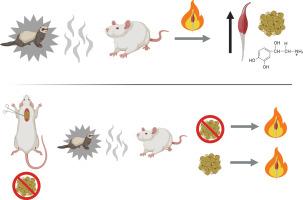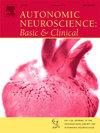暴露在捕食者的威胁下,交感神经系统向骨骼肌流出
IF 3.3
4区 医学
Q2 NEUROSCIENCES
引用次数: 0
摘要
由于肥胖和超重仍然是世界各地的公共卫生负担,因此寻求增加能量消耗(EE)的方法来扭转体重增加背后的能量不平衡。骨骼肌是增强能量消耗的一个有希望的目标。我们之前的研究表明,暴露在捕食者的气味中会诱导骨骼肌产热,导致大鼠的身体活动增加,能量消耗增加,体重减轻。先前的证据支持通过β肾上腺素能受体激活骨骼肌的交感神经系统(SNS)的重要性。在这里,我们测量了去甲肾上腺素周转率(NETO),以证明捕食者的威胁增加了大鼠向骨骼肌和棕色脂肪组织(BAT)以及一些白色脂肪库的SNS流出。我们手术切除了主要的BAT库,以探讨BAT对肌肉产热的潜在贡献。缺乏肩关节间BAT (iBATX)的大鼠在捕食者气味诱导的肌肉产热中没有明显的缺陷,但对β3肾上腺素能激动剂CL-316,243表现出不同的反应。总之,这重申了SNS向骨骼肌流出在食肉动物威胁引起的产热中的重要性。本文章由计算机程序翻译,如有差异,请以英文原文为准。

Exposure to predator threat engages sympathetic nervous system outflow to skeletal muscle
As obesity and overweight continue to be a public health burden throughout the world, approaches to increase energy expenditure (EE) are sought to reverse the energy imbalance underlying weight gain. Skeletal muscle is a promising target for enhancing energy expenditure. We have previously shown that exposure to predator odor induces skeletal muscle thermogenesis and results in increased physical activity, energy expenditure, and weight loss in rats. Prior evidence supports the importance of sympathetic nervous system (SNS) activation of skeletal muscle through β adrenergic receptors. Here, we measured norepinephrine turnover (NETO) rate to demonstrate that predator threat increases SNS outflow to skeletal muscle and brown adipose tissue (BAT), as well as some white adipose depots, in rats. We surgically excised the primary BAT depot to probe the potential contribution of BAT to muscle thermogenesis. Rats lacking interscapular BAT (iBATX) showed no discernable deficit in predator odor-induced muscle thermogenesis, but showed some differential response to the β3 adrenergic agonist CL-316,243. Altogether, this reaffirms the importance of SNS outflow to skeletal muscle in the thermogenesis elicited by predator threat.
求助全文
通过发布文献求助,成功后即可免费获取论文全文。
去求助
来源期刊
CiteScore
5.80
自引率
7.40%
发文量
83
审稿时长
66 days
期刊介绍:
This is an international journal with broad coverage of all aspects of the autonomic nervous system in man and animals. The main areas of interest include the innervation of blood vessels and viscera, autonomic ganglia, efferent and afferent autonomic pathways, and autonomic nuclei and pathways in the central nervous system.
The Editors will consider papers that deal with any aspect of the autonomic nervous system, including structure, physiology, pharmacology, biochemistry, development, evolution, ageing, behavioural aspects, integrative role and influence on emotional and physical states of the body. Interdisciplinary studies will be encouraged. Studies dealing with human pathology will be also welcome.

 求助内容:
求助内容: 应助结果提醒方式:
应助结果提醒方式:


